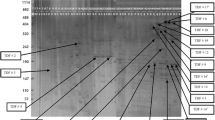Abstract
To compare differential gene expression among three ecotypes of reed (Phragmites communis Trin.), dune reed (DR), heavy-salt meadow reed (HSR) and light-salt meadow reed (LSR), mRNA transcripts were displayed by cDNA-AFLP (amplified fragment length polymorphisms). The result revealed that a relatively small number of genes are likely involved in adaptations of DR and HSR to stresses. A full-length cDNA encoding dTDP-D-glucose dehydratase gene (PcTGD) was subsequently cloned from DR. Northern blot analysis showed that it is highly expressed in stem as well as rhizoma of the three ecotypes. However, its expression in DR stem was much higher than that of the other two ecotypes. After the removal of water stress, the expression ofPcTGD was significantly reduced, suggesting that it possibly plays a role in adaptation of DR to water stress through an osmotic regulation mechanism.
Similar content being viewed by others
References
Boyer, J. S., Plant productivity and environment, Science, 1982, 218: 443.
Ingram, J., Bartels, D., The molecular basis of dehydration tolerance in plants, Annu. Rev. Plant. Physiol. Plant Mol. Biol., 1996, 47: 377.
Bray, E. A., Molecular responses to water deficit, Plant Physiol., 1993, 103: 1035.
Shinozaki, K., Yamaguchi-Shinozaki, K., Gene expression and signal transduction in water-stress response, Plant Physiol., 1997, 115: 327
Shinozaki, K., Yamaguchi-Shinozaki, K., Molecular responses to dehydration and low temperature: differences and cross-talk between two stress signaling pathways, Current Opinion in Plant Biology, 2000, 3: 217.
Riccardi, F., Gazeau, P., de Vienne, D. et al., Protein changes in response to progressive water deficit in maize, Plant Physiol., 1998, 117: 1253.
Xiong, L., Ishitani, M., Zhu, J. K., Interaction of osmotic stress, temperature and abscisic acid in the regulation of gene expression inArabidopsis, Plant Physiol., 1999, 119: 205.
Holmberg, N., Beulow, L., Improving stress tolerance in plants by gene transfer, Trends in Plant Science, 1998, 3: 1360.
Alonso-Blanco, C., Koornneef, M., Naturally occurring variation inArabidopsis: an underexploited resource for plant genetics, Trends in Plant Science, 2000, 5: 22.
Haslam, S. M., Variation of population type inphragmites communis Trin., Annals of Botany, 1970, 34: 147.
Haslam, S. M., The performance ofphragmites communis Trin. in relation to temperature, Annals of Botany, 1975, 39: 881.
Matoh, T., Matsushita, N., Takahashi, E., Salt tolerance of the reed plantsPhragmites communis, Physiol. Plant, 1988, 72: 8.
Pu, T. L., Cheng, Y. F., Zhang, C. L., Novel small compound specified in dune reed (phragmites communis Trin.) and its possible role as a protectant on the chloroplasts under stress, Chinese Science Bulletin, 2000, 45: 2062.
Bachem, C., van der Hoeven, R. de Bruijn, S. et al., Visualization of differential gene expression using a novel method of RNA fingerprinting based on AFLP: Analysis of gene expression during potato tuber development, Plant J., 1996, 9: 745.
Kushnir, S., Babiychuk, E., Kampfenkel, K. et al., Characterization ofArabidopsis thaliana cDNAs that render yeasts tolerant toward the thiol-oxidizing drug diamide, Proc. Natl. Acad. Sci. USA, 92: 10580.
Gygi, S., Rochon, Y., Franza, B. et al., 1999: Correlation between protein and mRNA abundance in yeast, Mol. Cell Biol., 1995, 19: 1720.
Takahashi, S., Katagiri, T., Yamaguchi-Shinozaki, K. et al., AnArabidopsis gene encoding a Ca2+-binding protein is induced by abscisic acid during dehydration, Plant Cell Physiol., 2000, 41: 898.
Bohnert, H., Jensen, R., Strategies for engineering water-stress tolerance in plants, Trends in Biotechnology, 1996, 14: 89.
Merson-Davis, L. Cundiffe, E., Analysis of five tylosin biosynthetic genes from thetyIIBA region of theStreptomyces fradiae genome, Mol. Microbiol., 1994, 13: 349.
Thorson, J. S., Lo, S. F., Ploux, O. et al., Studies of the biosynthesis of 3,6-dideoyhexoses: Molecular cloning and characterization of the asc (Ascarylose) region from Yersinia pseudotuberculosis serogroup VA, J. Bacteriol., 1994, 176: 5483.
Wang, H. L., Zhang, C. L., Chen, G. C., Osmotica for adaptation to the habitats in different ecotypes of reed plants in the Hexi Corridor, Acta Eco. Sin. (in Chinese), 1994, 14(supp): 56.
Author information
Authors and Affiliations
Corresponding authors
About this article
Cite this article
Cheng, Y., Pu, T., Xue, Y. et al. PcTGD, a highly expressed gene in stem, is related to water stress in reed (Phragmites communis Trin.). Chin.Sci.Bull. 46, 850–854 (2001). https://doi.org/10.1007/BF02900437
Received:
Issue Date:
DOI: https://doi.org/10.1007/BF02900437




